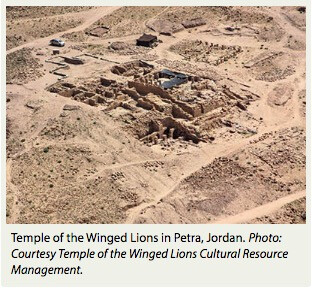Site-Seeing: Petra’s Temple of the Winged Lions
Petra, the 2,000-year-old capital city and trade emporium of the ancient Nabateans nestled amid the rugged mountain landscape of southern Jordan, is a marvel to behold. Visitors to the expansive site meander through narrow passageways and hike up secluded trails to take in the spectacular rock-cut architecture and enigmatic monuments built during the time the city was flourishing, when the Nabateans controlled the lucrative Arabian incense trade and laid claim to a powerful kingdom stretching from Damascus to the Hejaz.
While a visit to Petra is certainly awe-inspiring, the site’s impressive
monuments can, in many ways, overwhelm the touristic experience, with visitors so focused on snapping pictures and hurrying from one dramatic façade to another that they lose out on getting any dee
per sense of the place, its history or its people. (I know this was certainly my experience when I first visited Petra nearly 20 years ago.) Now, a new program led by the American Center of Oriental Research (ACOR) is, for the first time, allowing visitors to go beyond the monuments to actually discover and experience Petra’s past and present.
ACOR’s Experience Petra program takes place at the site of the Temple of the Winged Lions, an opulent colonnaded temple built to honor al-Uzza, the supreme goddess of the Nabateans. Built on a promontory overlooking the city center, the temple was a majestic sacred complex that featured a massive ascending staircase, a monumental entrance flanked by gigantic columns and an inner cultic chamber with a raised podium set amid a forest of columns. While most of the columns had beautiful Corinthian-style capitals, the dozen columns surrounding the main podium were adorned with the unique “winged lion” capitals that give the monument its name.
 First excavated more than 40 years ago the temple’s fragile sandstone walls and columns have suffered severe deterioration from both natural and human elements, and the temple is now in desperate need of conservation and repair. What is more, the temple’s excavation had a decidedly negative effect on the surrounding landscape, producing deep excavation trenches and intrusive spoil heaps that transformed the site into an inaccessible and even hazardous ruin that, for decades, was best avoided by tourists and locals alike.
First excavated more than 40 years ago the temple’s fragile sandstone walls and columns have suffered severe deterioration from both natural and human elements, and the temple is now in desperate need of conservation and repair. What is more, the temple’s excavation had a decidedly negative effect on the surrounding landscape, producing deep excavation trenches and intrusive spoil heaps that transformed the site into an inaccessible and even hazardous ruin that, for decades, was best avoided by tourists and locals alike.
Since 2009, ACOR, in cooperation with the Department of Antiquities of Jordan and the Petra Archaeological Park, has directed the Temple of the Winged Lions Cultural Resource Management (TWLCRM) Initiative (www.facebook.com/twlcrm), assembling a team of world-class scholars and professionals to document, conserve and ultimately bring new life to this remarkable monument of one of the world’s great wonders. At the same time, the project has developed an innovative social engagement strategy that directly involves members of Petra’s host communities in the project through year-round employment, training and educational opportunities in archaeology and cultural resource management. The TWLCRM’s path-breaking efforts have been funded through the U.S. State Department and USAID and have even earned the project the Archaeological Institute of America’s 2015 award for Best Practices in Site Preservation.
Now, through the Experience Petra program, the TWLCRM is inviting casual tourists to work alongside our specialists and trained local technicians to preserve this important monument of Petra’s past. In addition to participating in hands-on demonstrations of stone conservation methods and architectural documentation techniques, tourists experience archaeology firsthand by helping sift the site’s excavation spoil heaps in search of pottery, coins, lamps, figurines and other small objects that were discarded at the temple thousands of years ago but missed during the original excavation. Tourists also learn about the types, dates and function of pottery and other objects recovered during the sifting process. At the same time, in learning directly from local technicians and trainees, visitors gain a deeper appreciation of Petra’s vibrant local communities, as they hear the amazing personal stories of the project team, learn a little of the local Arabic dialect and even join the team in a glass of traditional Bedouin tea.
The Experience Petra tourism program is offered free of charge every Sunday at 11 a.m. to all visitors to the Temple of the Winged Lions site, with an activity program that takes a little more than an hour. In addition, fee-based customized programs can be designed with the TWLCRM upon request, while free site tours explaining the temple and the project are given at 11 a.m., Sunday through Thursday. The site is located within a 5-minute walk of the restaurants, museums and bathrooms found in the center of the Petra Archaeological Park, and it is especially convenient for those not interested in the more strenuous hikes to major Petra monuments, such as the Monastery or the High Place of Sacrifice.
Petra is certainly a marvel to behold, but without responsible archaeology and conservation of what has already been excavated, the site’s long-term preservation is in serious jeopardy. If you plan to visit Petra, be sure to join us at the TWLCRM Initiative, so that you, too, can be part of ensuring a sustainable future for this amazing archaeological site.
• 05/16/2017 - see more at this link

